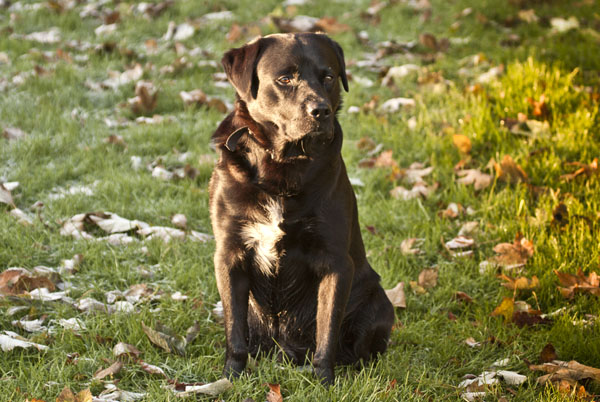HOW THE DOG LEARNS.
What follows is a brief overview of a huge subject; the subject of canine learning. Hopefully the following will give you some idea of what goes on inside your four legged friend and why they do what they do. As before I will endeavour to make things as easily understandable as possible for all.
All behaviour of a dog is either innate (genetic, born with it), or learnt through life. Innate learning is what it is; part of your dogs genetic make up, and how these genes eventually express themselves will be profoundly influenced by a dogs early learning and the environment in which things happen. The behaviour that is learnt through life is learnt three ways, those being observational learning, operant conditioning and classical conditioning.

INNATE LEARNING:-Firstly lets look at innate learning. A hard one to grasp but it is basically inherited behaviour from essential controlling genes; a blueprint for a dog if you like. Some of your dogs behaviour, especially when young, is fixed around natural reflexes or reactions to certain provoking stimuli. These reactions are known as fixed action patterns, they are "hard wired" into your dog and once started usually have to run to completion.
In pedigree dogs some behaviours or traits can be specific to that breed, the result of thousands of years of domestication, examples would be the Rottweiler to guarding, the Collie to herding and the Newfoundland to swimming.
A lot of things that a dog does is just a dog being a dog, it is in his or her genes, the problems arise when we as humans see this gene controlled behaviour as inappropriate in our human environment. All gene driven behaviours would be fine amongst a pack of feral dogs running wild in Yellowstone but maybe not in your local neighbourhood, park, or home, (remember though that the dog thinks this is normal for its genes tell it so). You as the owner have to teach and train your dog what is appropriate and acceptable behaviour, easier said than done but this site will help you if you read on.
As the inherited behaviour of a dog is so important it stands to reason that the parents of your new friend play a big role in this. A mix of their genes will be inherited and so their own behaviour should be viewed beforehand if possible, (more about this in the following chapters), suffice it to say I think good parentage is important.
This innate learning is out of your control, the result of thousands of years of evolution and domestication. Though as just mentioned good parents will help you and your dogs case. Some dogs behaviours or traits can be completely driven by their controlling genes and sometimes only management of any undesirable behaviours and not cure is possible.
OBSERVATIONAL/SOCIAL LEARNING:-
Lets take a look at the learnt behaviour and how it occurs. The first we will look at is observational learning. This is exactly as it sounds, your dog learns by watching and copying others, and the environment in which they do it will have major effect. Some things will be more influential in their learning, namely other known dogs, us, and the immediate environment.
Quite often in multi dog households a new dog will learn the behaviours (be they good or bad) of the existing members (not always though). If the behaviour of your existing dogs is bad chances are your new dog, especially if young or a puppy, will follow suit. If there are no other dogs in the household then he or she will learn from watching and interacting with you, your family, your visitors, your cats or any other critters, and its environment at any given time when learning is taking place.
It has been known for a dog or dogs to change their behaviour in favour of an older new dog coming into a household though you should never bank on it as a way to sort out your existing dogs bad behaviour. Bringing a new dog into a home with existing dog problems is generally not a good idea. An older dog coming into the household may bring different problems (more about that later).
Your dog will watch other dogs while out and about, watching how they interact, seeing how it should be done and attempt to interact him/herself. I cannot emphasise the importance of this enough, this early social learning is of the highest importance; more so than formal dog training classes. In my opinion it is far better to have a well socialised well rounded dog that comes back when you ask them too, than to have a dog that will do a pirouette on command but is a social nightmare.
MANY DOG ON DOG BEHAVIOURAL PROBLEMS ARE DUE TO LACK OF SOCIALISATION WITH OTHER DOGS WHEN YOUNG.
The two other forms of learning are both types of associative learning (learning through association), those being classical conditioning and operant conditioning. Without going into both in too much behavioural detail I will give you a good everyday example about what happens.
OPERANT CONDITIONING:-
Operant conditioning (or instrumental conditioning) is also known as trial and error conditioning or put more simply “if I do this, this will happen”. It is a form of associative learning. Your dog learns, sometimes very quickly, that if he does a certain behaviour, he gets a certain result. Put simply behaviour can be modified by positve or negative outcomes.
An easy example would be a dog barks non stop and eventually gets a chew to shut him up, he quickly learns that if he barks continuously he gets a chew and you giving him a chew is reinforcing this behaviour (positive reinforcement), so he will carry on doing it. If you were to completely ignore his barking chances are he would give up on it as there is no reward to the behaviour, but be advised it would probably get worse before it got better as he thinks this normally works and so barks even more at first until he eventually gets the message.
All of the above is a simplified version of operant conditioning but shows well what actually happens. Many behavioural problems are learnt this way and owners are unwittingly reinforcing the behaviours by rewarding it with treats, attention or anything that particular dog sees as important (a resource), in so doing you are allowing the undesirable behaviour to continue.
CLASSICAL CONDITIONING:-
The other form of associative learning is Classical conditioning; also known as stimulus/response conditioning. I think it is best again to give you a simple example of this learning in action to show you what it entails.
When you take your dog out for a walk obviously it is one of the highlights of the day and he/she may well get excited; sometimes well before you walk out the door. This happens because they have learnt to associate something you do with going out for a walk. Possibly it might be the drawer that you keep the lead in. They have associated you going to this particular drawer in which you keep the lead with going out for a walk. The very first time you done this the drawer with the lead in obviously meant nothing to them and their initial excitement was caused by heading for the door, but quickly, sometimes very quickly, they have associated this action of going to the drawer to get the lead out with going out for their walk and they get excited with the prospect of what’s to come. Going to the drawer has become the first association in a line of many with going out for a walk.
The above is classical conditioning in action; the dog has paired a previously unimportant thing (the drawer) with a natural response (excitement, at going out). Again many behavioural problems are learnt this way and it is the natural response to the previously unimportant stimulus that often becomes the problem.
All of the above are simplifying the learning processes of the dog and a good behaviourist would have a vast amount of knowledge and experience with these processes and would be able to use this knowledge to work out how a dog has learnt to do what they are doing and how to change it by employing the same learning processes to change the dogs behaviour and re-routing it to a more positive outcome.
I can not cover this here as any behaviour modifacation would need to be tailored to any individual dogs needs, as all are different, and after much history taking and evaluation, many other things have to be taken into consideration. It is just my intention to give a basic understanding about how dogs learn.
I should really also mention habituation and sensitisation in this topic. In a way they are learning but are really learning that modifies existing behaviour.
Habituation is where a dog gets used to a certain stimulus, say a washing machine; over time he gets used to the sound of the washing machine and in the end gives it no worth as it is of no consequence to him. He has become habitualised to it.
Sensitisation is in a way the opposite, take for instance a vacuum cleaner. A dog might become more scared of a vacuum cleaner over time and eventually just the slightest exposure to it will cause distress. Put behaviourally repeated exposure to a perceived scary stimulus results in progressive amplifacation (increasing) of the response: fear, shaking, hiding, cowering etc. Sensitisation is also open to the dog generalising to the stimulus. A good example of generalisation could be a dogs reaction to fireworks, the initial scary stimulus is the fireworks, but over time this generalises to many other bangs, gunshots when out and about for instance, and the response to gunshots becomes the same as to the fireworks. Some dogs can generalise their fear or anxiety in other ways, for instance a dog may be attacked by a particular German Shepard and then develop a fear of any German Shepard that comes near it in the future, or even worse any large dog that comes near.
If you do have problems then you should seek out a qualified, experienced and recommended behaviourist in your area. Try and find a proper behaviourist and not just a dog trainer as most behavioural problems can not be trained out of a dog. There is a huge difference between training a fairly well rounded dog to sit or stop pulling on a lead than to change a well entrenched behaviour in a badly socialised, outwardly aggressive dog. Hopefully reading through this site before acquiring a canine friend will help you avoid ever ending up in the later situation.
For further relevant reading take a look at my /how-dogs-communicate page.
Why not take a look at my first book- Elmer no ordinary wolf, a realistic novel about a wolf called Elmer, his family and their life. My hope is that after reading it you will have learnt much about wolves and mother nature, and where your dog came from.
copyright 2013-22 Paul lindley
Topics
